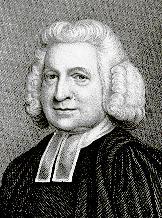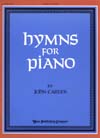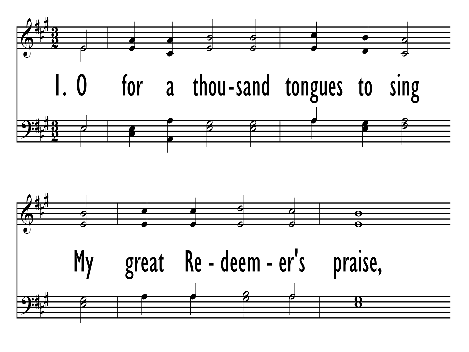- |
User Links
O for a Thousand Tongues

O for a thousand tongues to sing My dear Redeemer's praise
Author: Charles Wesley (1739)Opening Hymns
Published in 1775 hymnals
Printable scores: PDF, MusicXMLPlayable presentation: Lyrics only, lyrics + musicAudio files: MIDI, Recording
Representative Text
1 O for a thousand tongues to sing
my great Redeemer's praise,
the glories of my God and King,
the triumphs of his grace!
2 My gracious Master and my God,
assist me to proclaim,
to spread thro' all the earth abroad
the honors of your name.
3 Jesus! the name that charms our fears,
that bids our sorrows cease,
'tis music in the sinner's ears,
'tis life and health and peace.
4 He breaks the power of cancelled sin,
he sets the prisoner free;
his blood can make the foulest clean;
his blood availed for me.
5 To God all glory, praise, and love
be now and ever given
by saints below and saints above,
the Church in earth and heaven.
Worship & Rejoice, 2003
Author: Charles Wesley
 Charles Wesley, M.A. was the great hymn-writer of the Wesley family, perhaps, taking quantity and quality into consideration, the great hymn-writer of all ages. Charles Wesley was the youngest son and 18th child of Samuel and Susanna Wesley, and was born at Epworth Rectory, Dec. 18, 1707. In 1716 he went to Westminster School, being provided with a home and board by his elder brother Samuel, then usher at the school, until 1721, when he was elected King's Scholar, and as such received his board and education free. In 1726 Charles Wesley was elected to a Westminster studentship at Christ Church, Oxford, where he took his degree in 1729, and became a college tutor. In the early part of the same year his religious impressions were much deepene… Go to person page >
Charles Wesley, M.A. was the great hymn-writer of the Wesley family, perhaps, taking quantity and quality into consideration, the great hymn-writer of all ages. Charles Wesley was the youngest son and 18th child of Samuel and Susanna Wesley, and was born at Epworth Rectory, Dec. 18, 1707. In 1716 he went to Westminster School, being provided with a home and board by his elder brother Samuel, then usher at the school, until 1721, when he was elected King's Scholar, and as such received his board and education free. In 1726 Charles Wesley was elected to a Westminster studentship at Christ Church, Oxford, where he took his degree in 1729, and became a college tutor. In the early part of the same year his religious impressions were much deepene… Go to person page >Text Information
Related Texts
| First Line: | O for a thousand tongues to sing My dear Redeemer's praise |
| Title: | O for a Thousand Tongues |
| Author: | Charles Wesley (1739) |
| Meter: | 8.6.8.6 |
| Place of Origin: | England |
| Language: | English |
| Notes: | Spanish translation: See "Quisiera yo con lenguas mil" by M. Candill |
| Copyright: | Public Domain |
| Liturgical Use: | Opening Hymns |
| Article: | "O for a Thousand Tongues to Sing" by Charles Wesley - by Robin Knowles Wallace (from "The Hymn") |
- (hymns)
- (hymns)
- (hymns)
- (hymns)
- (hymns)
- (hymns)
- (hymns)
- (hymns)
- (hymns)
- (hymns)
- (hymns)
- (hymns)
- Psalm 72:115 (hymns)
- (hymns)
- (hymns)
- (hymns)
- (hymns)
- (hymns)
- (hymns)
- (hymns)
- (hymns)
- (hymns)
- (hymns)
- (hymns)
- (hymns)
- (hymns)
- (hymns)
- (hymns)
- (hymns)
- (hymns)
- (hymns)
- (hymns)
- (hymns)
- (hymns)
- (hymns)
- (hymns)
- (hymns)
- (hymns)
- (hymns)
- (hymns)
- (hymns)
- (hymns)
- (hymns)
- (hymns)
- (hymns)
- (hymns)
- (hymns)
- (hymns)
- (hymns)
- (hymns)
- (hymns)
- (hymns)
- (hymns)
- (hymns)
- (hymns)
- (hymns)
- (hymns)
- (hymns)
- (hymns)
- (hymns)
- (hymns)
- (hymns)
- (hymns)
- (hymns)
- (hymns)
- (hymns)
- (hymns)
- (hymns)
- (hymns)
- (hymns)
- (hymns)
- (hymns)
- (hymns)
- (hymns)
- (hymns)
- (hymns)
- (hymns)
- (hymns)
- (hymns)
- (hymns)
- (hymns)
- (hymns)
- (hymns)
- (hymns)
- (hymns)
- (hymns)
- (hymns)
- (hymns)
- (hymns)
- (hymns)
- (hymns)
- (hymns)
- (hymns)
- (hymns)
- (hymns)
- (hymns)
- (hymns)
- (hymns)
- (hymns)
- (hymns)
- (hymns)
- (hymns)
- (hymns)
- (hymns)
- (hymns)
- Year A, Advent, Third Sunday
This is recommended for Year A, Advent, Third Sunday by 2 hymnal lectionary indexes including Lift Up Your Hearts: psalms, hymns, and spiritual songs #590. - Year A, Advent, Third Sunday
- Year A, Ordinary Time, Proper 21 (26)
This is recommended for Year A, Ordinary Time, Proper 21 (26) by 2 hymnal lectionary indexes. - Year A, Ordinary Time, All Saints Day
- Year B, Advent, Third Sunday
This is recommended for Year B, Advent, Third Sunday by 2 hymnal lectionary indexes including Lift Up Your Hearts: psalms, hymns, and spiritual songs #590. - Year B, Epiphany season, Second Sunday
- Year B, Epiphany season, Sixth Sunday
This is recommended for Year B, Epiphany season, Sixth Sunday by 2 hymnal lectionary indexes including Lift Up Your Hearts: psalms, hymns, and spiritual songs #590. - Year B, Epiphany season, Seventh Sunday
This is recommended for Year B, Epiphany season, Seventh Sunday by 3 hymnal lectionary indexes including Lift Up Your Hearts: psalms, hymns, and spiritual songs #590. - Year B, Lent, Fourth Sunday
This is recommended for Year B, Lent, Fourth Sunday by 2 hymnal lectionary indexes including Glory to God: the Presbyterian Hymnal #610 and Lift Up Your Hearts: psalms, hymns, and spiritual songs #590. - Year B, Easter season, Fourth Sunday
This is recommended for Year B, Easter season, Fourth Sunday by 2 hymnal lectionary indexes including Lift Up Your Hearts: psalms, hymns, and spiritual songs #590. - Year B, Ordinary Time, Proper 8 (13)
This is recommended for Year B, Ordinary Time, Proper 8 (13) by 2 hymnal lectionary indexes including Lift Up Your Hearts: psalms, hymns, and spiritual songs #590. - Year B, Ordinary Time, Proper 9 (14)
- Year B, Ordinary Time, Proper 17 (22)
- Year B, Ordinary Time, Proper 18 (23)
This is recommended for Year B, Ordinary Time, Proper 18 (23) by 3 hymnal lectionary indexes including Glory to God: the Presbyterian Hymnal #610 and Lift Up Your Hearts: psalms, hymns, and spiritual songs #590. - Year B, Ordinary Time, Proper 25 (30)
This is recommended for Year B, Ordinary Time, Proper 25 (30) by 2 hymnal lectionary indexes including Lift Up Your Hearts: psalms, hymns, and spiritual songs #590. - Year B, Ordinary Time, Thanksgiving Day
This is recommended for Year B, Ordinary Time, Thanksgiving Day by 2 hymnal lectionary indexes including Glory to God: the Presbyterian Hymnal #610. - Year C, Advent, Third Sunday
This is recommended for Year C, Advent, Third Sunday by 3 hymnal lectionary indexes including Glory to God: the Presbyterian Hymnal #610 and Lift Up Your Hearts: psalms, hymns, and spiritual songs #590. - Year C, Advent, Third Sunday
- Year C, Epiphany season, Third Sunday
This is recommended for Year C, Epiphany season, Third Sunday by 2 hymnal lectionary indexes including Lift Up Your Hearts: psalms, hymns, and spiritual songs #590. - Year C, Epiphany season, Third Sunday
- Year C, Epiphany Season, Ninth Sunday
This is recommended for Year C, Epiphany Season, Ninth Sunday by 2 hymnal lectionary indexes including Lift Up Your Hearts: psalms, hymns, and spiritual songs #590. - Year C, Ordinary Time, Proper 3 (8)
- Year C, Ordinary Time, Proper 5 (10)
This is recommended for Year C, Ordinary Time, Proper 5 (10) by 4 hymnal lectionary indexes including Glory to God: the Presbyterian Hymnal #610 and Lift Up Your Hearts: psalms, hymns, and spiritual songs #590. - Year C, Ordinary Time, Proper 6 (11)
- Year C, Ordinary Time, Proper 10 (15)
This is recommended for Year C, Ordinary Time, Proper 10 (15) by 2 hymnal lectionary indexes including Lift Up Your Hearts: psalms, hymns, and spiritual songs #590. - Year C, Ordinary Time, Proper 23 (28)
This is recommended for Year C, Ordinary Time, Proper 23 (28) by 2 hymnal lectionary indexes including Lift Up Your Hearts: psalms, hymns, and spiritual songs #590. - Year C, Ordinary Time, Proper 29 (34)
This is recommended for Year C, Ordinary Time, Proper 29 (34) by 2 hymnal lectionary indexes including Lift Up Your Hearts: psalms, hymns, and spiritual songs #590. - Year C, Ordinary Time, Proper 29 (34)
Aymara
English
- 112 Familiar Hymns and Gospel Songs #102
- A Baptist Hymn Book, Designed Especially for the Regular Baptist Church and All Lovers of Truth #d563
- A Book of Worship for the Use of the Evangelical Lutheran Church ... of the Church of the Redeemer, Richmond, Virginia #d123
- A Choice Collection of Hymns and Spiritual Songs: intended for the edification of sincere Christians of all denominations #XLII
- A Choice Selection of Evangelical Hymns, from various authors: for the use of the English Evangelical Lutheran Church in New York #199
- A Choice Selection of Hymns and Spiritual Songs for the use of the Baptist Church and all lovers of song #31
- A Choice Selection of Hymns. 2nd ed. #d155
- A Choice Selection of Hymns. 6th ed. #d189
- A Chord #d79
- A Collection of Choral Hymns for the ... Hanson Place Methodist Episcopal Congregation #d131 10 shown out of 1200
French
French Creole
German
Japanese
Korean
- Glory to God: the Presbyterian Hymnal #610
- Lift Up Your Hearts: psalms, hymns, and spiritual songs #590
- Santo, Santo, Santo: cantos para el pueblo de Dios = Holy, Holy, Holy: songs for the people of God #439
- 찬송과 예배 = Chansong gwa yebae = Come, Let Us Worship: the Korean-English Presbyterian hymnal and service book #226
Mandarin
Portuguese
Spanish
Swedish
Welsh
Notes
Scripture References:
st. 1-2 = Ps.145:10-12
st. 2 = Luke 4:18-19, Isa. 61:1-2
st. 3 = Acts 3:16, Rom. 5:1
st. 4 = Col. 2:14
st. 5 = Heb. 2:4
st. 6 = Matt. 11:5, Isa.35:6, Acts 3:8
st. 7 = Rev. 5:13
In 1739, for the first anniversary of his conversion, Charles Wesley (PHH 267) wrote an eighteen-stanza text beginning "Glory to God, and praise and love." It was published in Hymns and Sacred Poems (1740), a hymnal compiled by Wesley and his brother John. The familiar hymn "Oh, for a Thousand Tongues" comes from stanzas 1 and 7-12 of this longer text (this pattern already occurs in Richard Conyers's Collection of Psalms and Hymns 1772). Stanza 7 is the doxology stanza that began the original hymn. Wesley acquired the title phrase of this text from Peter Böhler, a Moravian, who said to Wesley, "If I had a thousand tongues, I would praise Christ with them all" (Böhler was actually quoting from Johann Mentzner's German hymn "O dass ich tausend Zungen hätte").
Through this jubilant, partly autobiographical text Wesley exalts his Redeemer and Lord. With its many biblical allusions it has become a great favorite of many Christians.
Liturgical Use:
Many types of services; profession of faith; baptism; other times of renewal; Pentecost.
--Psalter Hymnal Handbook
Access an additional article on the Canterbury Dictionary of Hymnology:
Tune
AZMONLowell Mason (PHH 96) adapted AZMON from a melody composed by Carl G. Gläser in 1828. Mason published a duple-meter version in his Modern Psalmist (1839) but changed it to triple meter in his later publications. Mason used (often obscure) biblical names for his tune titles; Azmon, a city south of C…
BLESSED NAME (Hudson)
For Leaders
“If I had a thousand tongues, I would praise Christ with them all.” So said Peter Böhler to Charles Wesley, inspiring the first line of the classic hymn, “Oh, for a thousand tongues to sing, my great Redeemer’s praise” (Psalter Hymnal Handbook.) Written to celebrate the one year anniversary of Charles’ conversion to Christianity, this declaration of Christ’s power and victory in his own life, rich in Biblical imagery of the Kingdom of God, becomes our own hymn of praise. We stand with the angels before the throne of God, lifting our voices as one church to glorify the one who “bids our sorrows cease.”
And yet, we also sing in the knowledge that the Kingdom of God is not yet fully realized. We proclaim Christ’s victory as a declaration of hope that we will see Christ reign over all. We stand with the voiceless, the lame, the prisoner, and the sorrowing, and lift our song of expectation.
Text:
Originally consisting of eighteen stanzas, most hymnals have modified the text to include stanzas 7-12 (the first six stanzas are primarily autobiographical of Wesley’s conversion experience), and end with the original stanza 1, the doxology stanza. The title of the song was acquired by Wesley from his friend Peter Böhler, a Moravian, who said, “If I had a thousand tongues, I would praise Christ with them all” (Psalter Hymnal Handbook.) Böhler was in fact quoting from Johan Mentzner’s German Hymn, “O dass ich tausend Zungen hätte,” (“Oh that I had a Thousand Voices.”) The reference to “a thousand tongues” may allude to Revelation 5:11: “I heard the voice of many angels, numbering thousands upon thousands.”
The reference to Revelation is not accidental. The hymn is rich in imagery of the Kingdom of God, both now and in the new heaven and earth. The text speaks of the power of Christ to heal, to forgive sins, to comfort, and to make us new and clean. As such, it acts both as a declaration of what Christ has already done in us, and as a reminder of the hope we have in what is yet to come. To declare the present-tense work of Christ, some hymnals have changed the line “his blood availed for me” in the fourth stanza to “his blood avails for me.”
Tune:
The most common tune used for this hymn, especially in the United States, is AZMON, a tune adapted by Lowell Mason. The British often use RICHMOND or LYNGHAM. David Crowder provides a contemporary setting of the hymn, using the tune AZMON with guitar and drums and adding an original refrain: “So come on and sing out, let our anthem grow loud, there is one great Love, Jesus.” This setting works particularly well when the hymn is paired with another contemporary song such as “He Reigns” or “Revelation Song” (see "When/Why/How" below). Another option for both organ and praise bands is to begin the hymn with the organ through stanza 1, hold on to the organ on the final note of the verse and softly bring in a guitar riff and build into the second verse with piano and drums. Bring the organ back in as a synth foundation after a few verses. This can be a powerful way of blending old and new worship styles.
Matthew Perryman Jones wrote a new tune for Indelible Grace that uses the words "O for a thousand tongues to sing" as a refrain. You can find his version and a lead sheet on Indelible Grace's website.
How/Why/When:
Because of the two-fold function of the hymn as both present declaration and future hope, the hymn can be used in a variety of ways throughout the liturgical year and throughout the worship service. Some suggestions are:
- Pentecost: use to focus on the Holy Spirit enabling all to speak and hear the Gospel with “a thousand tongues.”
- World Communion Sunday: again primarily referencing “a thousand tongues,” this is a powerful hymn of unity in the global church. To pair it with a contemporary song, try transitioning out of this hymn into “He Reigns” by the Newsboys, another song about the church around the world lifting their voices to praise God. Another option is to put the text of the hymn to a different tune from another culture or time – for example, use the tune MCKEE, a 20th century African-American tune.
- Christ the King Sunday: this lesser known liturgical marker is the last Sunday before Advent begins, and is a time in which the church declares Christ to be king over all. The hymn “All Creatures of our God and King” offers a beautiful tie-in to both the theme of kingship and unity of the church. Using the words of this hymn that declares Christ’s victory, a worship leader could also pray that the church would continue to see that victory in our lives today; that we would see the “broken hearts rejoice,” and all “our sorrows cease.”
- Advent: when used in the Advent season, this hymn can primarily be sung as a prayer of longing for the second coming of Christ and the complete redemption of all things, for Christ’s kingship to be evident to all. A possible contemporary song to pair it with in this case is “Revelation Song” by Kari Jobe.
Within a worship service, the hymn can be sung in many places:
- Praise – Frame with Scripture from Rev. 5:13 – “To him who sits on the throne and to the Lamb be praise and honor and glory and power, forever and ever!” or Psalm 145:10-12: “All your works praise you, Lord…”
- Assurance of Pardon - Col. 2:14 can be said as the Assurance, as the words “having canceled the charge of our legal indebtedness, which stood against us and condemned us; he has taken it away, nailing it to the cross” directly reference stanza 4.
- Intercessory Prayer - As mentioned above, the words of this hymn could easily be used as a spoken prayer of intercession, potentially as a framework within which specific prayers of the congregation are offered. The hymn can also be sung as a response to an intercessory prayer.
Suggested music:
- O for A Thouaand Tongues to Sing - for Choir
- Weber, Paul D. Oh, for a Thousand Tongues to Sing - (Choral score) - Choir with optional Congregation part
- Raney, Joel. O For a Thousand Tongues To Sing - Choir, piano, and handbells
- Smith, Mark Brampton. Partita on Azmon - Organ
Laura de Jong, Hymnary.org
Timeline
Arrangements
Media
- MIDI file from Baptist Hymnal 1991 #206
- Audio recording from Baptist Hymnal 1991 #206
- MIDI file from Baptist Hymnal 1991 #206
- MIDI file from Baptist Hymnal 1991 #216
- Audio recording from Baptist Hymnal 1991 #216
- MIDI file from Baptist Hymnal 1991 #216
- MIDI file from The Cyber Hymnal #4815
- Audio recording from Evangelical Lutheran Worship #886
- MIDI file from Gloria Deo: a Collection of Hymns and Tunes for Public Worship in all Departments of the Church #636
- Audio recording from Glory to God: the Presbyterian Hymnal #610
- Audio recording from Lift Up Your Hearts: psalms, hymns, and spiritual songs #590
- Audio recording from Lift Up Your Hearts: psalms, hymns, and spiritual songs #590
- Audio recording from Lift Up Your Hearts: psalms, hymns, and spiritual songs #590
- Audio recording from Lift Up Your Hearts: psalms, hymns, and spiritual songs #590
- Audio recording from Lift Up Your Hearts: psalms, hymns, and spiritual songs #590
- Audio recording from Psalter Hymnal (Gray) #501
- MIDI file from Psalter Hymnal (Gray) #501
- MIDI file from Psalter Hymnal (Gray) #501
- Audio recording from Small Church Music #102
- Audio recording from Small Church Music #102
- Audio recording from Small Church Music #102
- Audio recording from Small Church Music #103
- Audio recording from Small Church Music #103
- MIDI file from Songs of Love and Praise No. 4 #214
- Audio recording from Trinity Hymnal (Rev. ed.) #164
- Audio recording from The Worshiping Church #130
- MIDI file from The United Methodist Hymnal #57
- Audio recording from The United Methodist Hymnal #57
- Audio recording from The United Methodist Hymnal #57b
- MIDI file from Worship and Rejoice #96


 My Starred Hymns
My Starred Hymns






